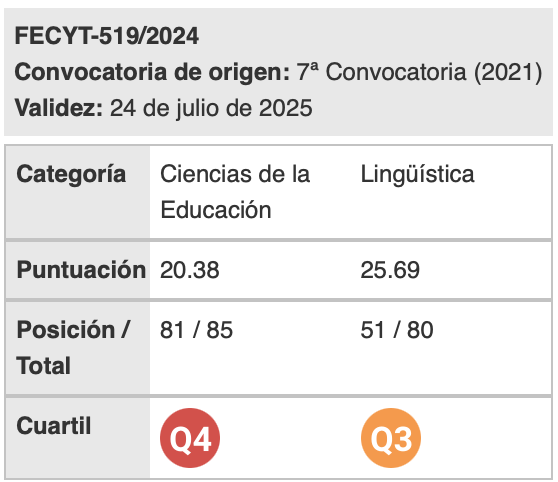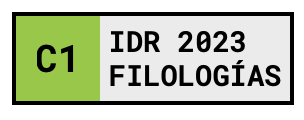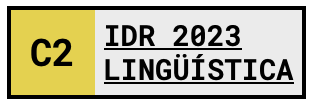The Spanish lexicon of flight: A lexicographical project for the domain of air transport
Keywords:
lexicography, specialized lexicons, speech, SpanishAbstract
The lexicon of air transport has received the influence of terms from other modalities of locomotion, of sciences such as meteorology and ornithology and it has also incorporated loan words from different languages. Although it has been the object of lexicological study in different languages, there are few studies that address the appropriation of this lexicon bynon-specialists and no dictionary exists that accounts for the non-technical uses of such lexi-cal units. This article presents the lexicographic decisions adopted to design El léxico españoldel vuelo, a proposal that attempts to record the daily use of Spanish aeronautical words, giving an account of their diatopic, diachronic and diaphasic variation. Specifically, it de-scribes both the selection of materials and the conformation of the lexical database as well as the text macrostructure, the criteria that operated in the lemmas selection and ordering and, finally, the microstructure of the lexicographic articles.
Downloads
References
Academia Argentina de Letras (2008). Diccionario del Habla de los Argentinos. Buenos Aires: Emecé Editores.
Álvarez-Amandi, C. & Uruburu, A. (1988). Análisis semántico del lenguaje de la aviación. En M. V. Romero, F. Lautre & C. Saralegui (Eds.), Actas del 5º Congreso Nacional de Lingüística Aplicada. La enseñanza de la lengua con fines específicos (pp. 101–09). Pamplona: Universidad de Navarra y Asociación Española de Lingüística Aplicada (AESLA).
Barcia, P. L. (s/f) Prólogo de la Colección «La Academia y la lengua del pueblo». . [5/4/2017].
Bosque, I. (Dir.) (2008). REDES. Diccionario combinatorio del español contemporáneo. Madrid: Ediciones SM.
Cabrè, Ma. T. (1999). La terminología: representación y comunicación. Elementos para una teoría de base comunicativa y otros artículos. Barcelona: Institut Universitari de Lingüística Aplicada.
Cabrè, Ma. T. & J. Gómez de Enterría (2006). La enseñanza de los lenguajes de especialidad. La simulación global. Madrid: Gredos.
Casares, J. (1950). Punto redondo. Diario ABC, 24/6/1950, p. 3.
Cayuela, N. (2002). Diccionario de uso del español de América y España. Barcelona: VOX.
Autor (2005) Entre “Zeppelines” y “Boeings 747”: metáforas del vuelo y la aviación en el habla cotidiana en español bonaerense. Literatura y Lingüística, 16, 221-245. <http://www.scielo.cl/pdf/lyl/n25/art13.pdf> [5/4/2017].
Autor (2009). Mito y ciencia en la representación discursiva de los inventores de globos aerostáticos y de los primeros aeronautas en textos de hablantes de español peninsular. Lingüística y Literatura, 56, 126-154. <http://aprendeenlinea.udea.edu.co/revistas/index.php/lyl/article/view/5174> [5/4/2017].
Autor (2010). Sobre el concepto de seguridad lingüística: propuesta de formulación para contextos institucionales específicos. Tonos Digital, 19. <http://www.um.es/tonosdigital> [5/4/2017].
Autor (2011). Aviación y volación: un caso de variación léxica entre el español peninsular y el español bonaerense a principios del siglo XX. En Rojas Mayer, E. M. (Coord.), Léxico e Interculturalidad: nuevas perspectivas (pp. 403-19). Tucumán: Instituto de Investigaciones Lingüísticas y Literarias Hispanoamericanas, Universidad Nacional de Tucumán.
Autor (2012). Expresiones de origen náutico en el nacimiento de las distintas formas de volar: aerostación, aviación y astronáutica. Literatura y Lingüística, 25, 275-298. <http://www.scielo.cl/scielo.php?script=sci_arttext&pid=S0716-58112012000100013> [5/4/2017].
Autor (2014). «Señoritas en busca de nombre»: jerarquización de una profesión a través del léxico. Revista de Lexicografía XX, 77-106.
Departamento de Investigaciones Lingüísticas y Filológicas (2008). Léxico del automóvil. Buenos Aires: Academia Argentina de Letras.
Estopá, R. (1998). El léxico especializado en los diccionarios de la lengua general: las marcas temáticas. Revista Española de Lingüística, 28(2), 359-387.
Fontanella de Weinberg, Ma. B. (1995). El español de América. Madrid: Mapfre.
Fritz, G. (1988). Cambio de significado y cambio de vocabulario. En Ammon, U, Dittmar, N. & K. Mattheier (Eds.), Sociolinguistics (II, pp. 1614-31). Berlín: Walter de Gruyter.
Gómez de Enterría Sánchez, J. (2009). El español lengua de especialidad: enseñanza y aprendizaje. Madrid: Arco/Libros.
Guilbert, L. (1965). La formation du vocabulaire de l'aviation. Paris: Larousse.
Haensch, G. & R. Werner (2000). Diccionario del español de Argentina. Madrid: Gredos.
Haensch, G., Wolf, L., Ettinger, S. & Werner, R. (1982) La lexicografía: de la lingüística teórica a la lexicografía práctica. Madrid: Gredos.
Medina Guerra, A. (Coord.) (2003). Lexicografìa española. Barcelona: Ariel.
Moliner, M. (2007). Diccionario de uso del español. Madrid: Gredos. [DUE]
Nisbet, R. (1981). Historia de la idea del progreso. Barcelona: Gedisa.
Porto Dapena, J. (2002). Manual de técnica lexicográfica. Madrid: Arco Libros.
Quiroga Salcedo, C. & Llull Offenbeck, G. (2008). Léxico del ciclismo. Academia Argentina de Letras: Buenos Aires.
Real Academia Española (1966). Diccionario Histórico de la Lengua Española. Madrid. [DHLE]
Real Academia Española (2014). Diccionario de la Lengua Española. Madrid: Planeta. 23ª Ed. <http://dle.rae.es> [DLE]
Rodríguez Ortiz, F. (2003). Los ejemplos de las técnicas decimonónicas: el ferrocarril. Asclepio, LV(2), 119-133. <http://asclepio.revistas.csic.es/index.php/asclepio/article/viewArticle/106> [5/4/2017].
Seco, M. (Dir.) (1999) Diccionario del español actual. Madrid: Santillana. [DEA]
Stubelius, S. (1958). Airship, aeroplane, aircraft. Studies in the history of terms for aircraft in English. Göteborg: Almqvist y Wiksell.
Stubelius, S. (1960). Balloon, flying-machine, helicopter. Further studies in the history of terms for aircraft in English. Göteborg: Lund.
Viljanen, K. (2007). Wing, aile, Flügel. The origins and development of central aeronautical terms in some languages, Turku.
Vivanco Cervero, V. (1999). Léxico técnico aeronáutico: formación, contaminación y solución. Barcelona: UNED, tesis doctoral.
Vivanco Cervero, V. (2006). El español de la ciencia y la tecnología. Madrid: Arco/Libros.
Downloads
Published
How to Cite
Issue
Section
License
Authors who publish with this journal agree to the following terms:
- Authors retain copyright and grant the journal right of first publication with the work simultaneously licensed under a Creative Commons Attribution License that allows others to share the work with an acknowledgement of the work's authorship and initial publication in this journal.
- Authors are able to enter into separate, additional contractual arrangements for the non-exclusive distribution of the journal's published version of the work (e.g., post it to an institutional repository or publish it in a book), with an acknowledgement of its initial publication in this journal.
- Authors are permitted and encouraged to post their work online (e.g., in institutional repositories or on their website) prior to and during the submission process, as it can lead to productive exchanges, as well as earlier and greater citation of published work (See The Effect of Open Access).

Revista de Lenguas para fines específicos is licensed under a Creative Commons Reconocimiento-NoComercial-SinObraDerivada 4.0 Internacional License.
























